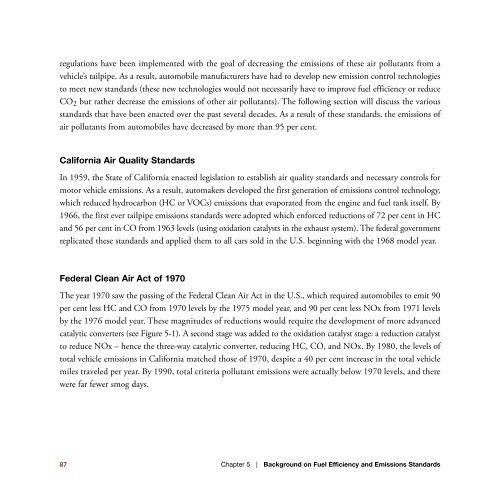Primer on Automobile Fuel Efficiency and Emissions - Pollution Probe
Primer on Automobile Fuel Efficiency and Emissions - Pollution Probe
Primer on Automobile Fuel Efficiency and Emissions - Pollution Probe
You also want an ePaper? Increase the reach of your titles
YUMPU automatically turns print PDFs into web optimized ePapers that Google loves.
egulati<strong>on</strong>s have been implemented with the goal of decreasing the emissi<strong>on</strong>s of these air pollutants from a<br />
vehicle’s tailpipe. As a result, automobile manufacturers have had to develop new emissi<strong>on</strong> c<strong>on</strong>trol technologies<br />
to meet new st<strong>and</strong>ards (these new technologies would not necessarily have to improve fuel efficiency or reduce<br />
CO 2 but rather decrease the emissi<strong>on</strong>s of other air pollutants). The following secti<strong>on</strong> will discuss the various<br />
st<strong>and</strong>ards that have been enacted over the past several decades. As a result of these st<strong>and</strong>ards, the emissi<strong>on</strong>s of<br />
air pollutants from automobiles have decreased by more than 95 per cent.<br />
California Air Quality St<strong>and</strong>ards<br />
In 1959, the State of California enacted legislati<strong>on</strong> to establish air quality st<strong>and</strong>ards <strong>and</strong> necessary c<strong>on</strong>trols for<br />
motor vehicle emissi<strong>on</strong>s. As a result, automakers developed the first generati<strong>on</strong> of emissi<strong>on</strong>s c<strong>on</strong>trol technology,<br />
which reduced hydrocarb<strong>on</strong> (HC or VOCs) emissi<strong>on</strong>s that evaporated from the engine <strong>and</strong> fuel tank itself. By<br />
1966, the first ever tailpipe emissi<strong>on</strong>s st<strong>and</strong>ards were adopted which enforced reducti<strong>on</strong>s of 72 per cent in HC<br />
<strong>and</strong> 56 per cent in CO from 1963 levels (using oxidati<strong>on</strong> catalysts in the exhaust system). The federal government<br />
replicated these st<strong>and</strong>ards <strong>and</strong> applied them to all cars sold in the U.S. beginning with the 1968 model year.<br />
Federal Clean Air Act of 1970<br />
The year 1970 saw the passing of the Federal Clean Air Act in the U.S., which required automobiles to emit 90<br />
per cent less HC <strong>and</strong> CO from 1970 levels by the 1975 model year, <strong>and</strong> 90 per cent less NOx from 1971 levels<br />
by the 1976 model year. These magnitudes of reducti<strong>on</strong>s would require the development of more advanced<br />
catalytic c<strong>on</strong>verters (see Figure 5-1). A sec<strong>on</strong>d stage was added to the oxidati<strong>on</strong> catalyst stage: a reducti<strong>on</strong> catalyst<br />
to reduce NOx – hence the three-way catalytic c<strong>on</strong>verter, reducing HC, CO, <strong>and</strong> NOx. By 1980, the levels of<br />
total vehicle emissi<strong>on</strong>s in California matched those of 1970, despite a 40 per cent increase in the total vehicle<br />
miles traveled per year. By 1990, total criteria pollutant emissi<strong>on</strong>s were actually below 1970 levels, <strong>and</strong> there<br />
were far fewer smog days.<br />
87 Chapter 5 | Background <strong>on</strong> <strong>Fuel</strong> <strong>Efficiency</strong> <strong>and</strong> Emissi<strong>on</strong>s St<strong>and</strong>ards
















